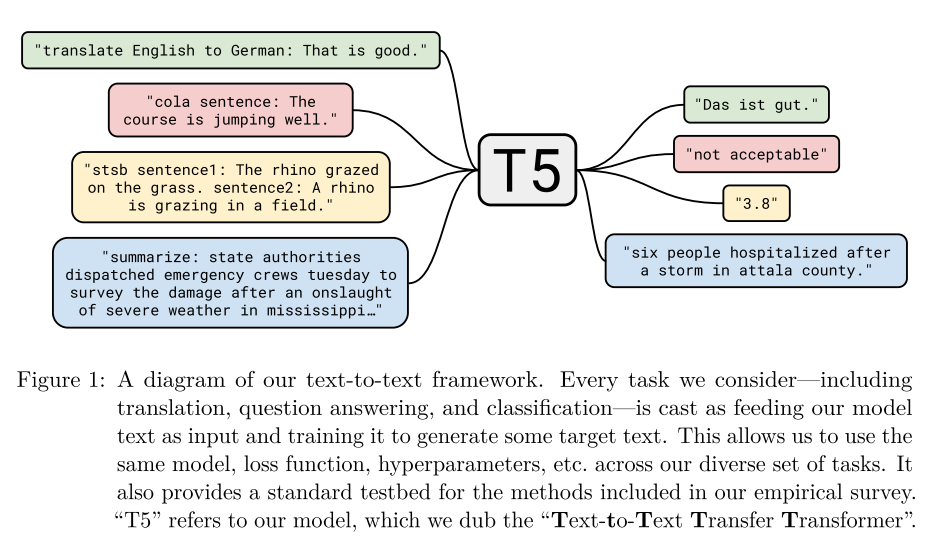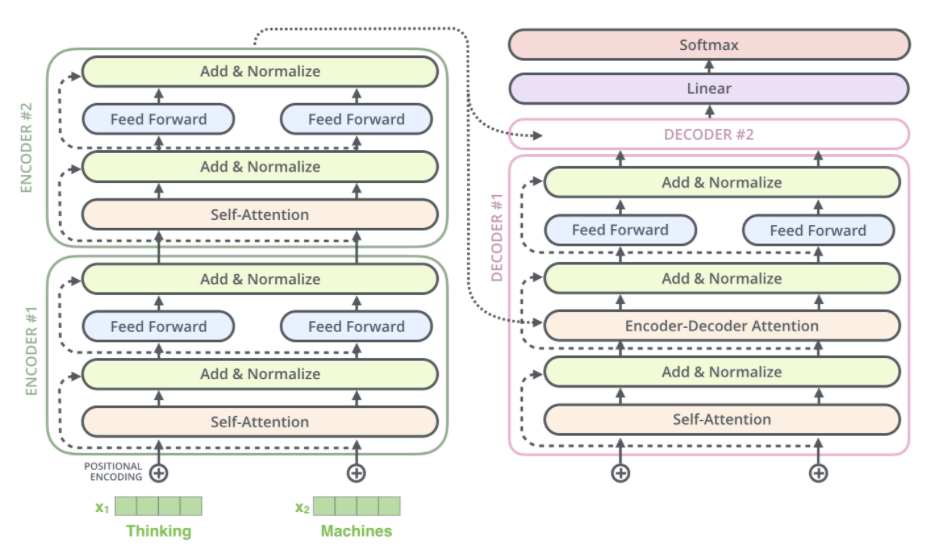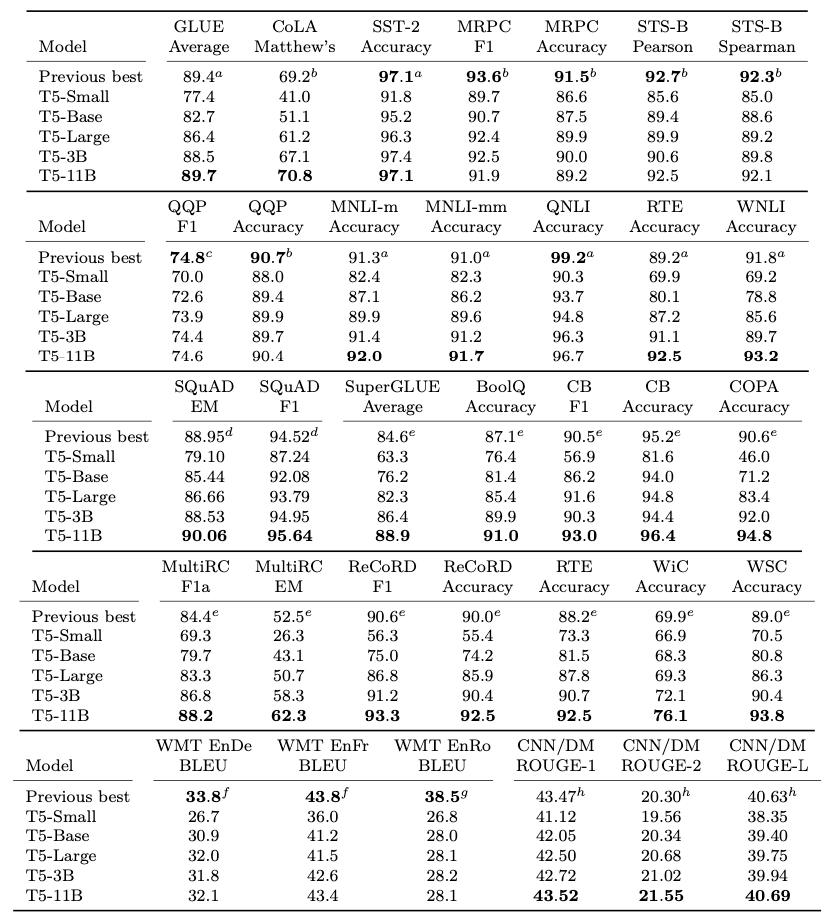A Searching and Summarizing Engine leveraging a custom-built search engine for news keyword searching, and a pre-trained transformers-based T5 Model, fine-tuned on news text and summary data to achieve state-of-the-art results on text summarization
- T5 Text Search and Summarize Engine
- Table of Contents
- 1 Features
- 2 Installation/Usage
- 3 Project Overview
- 4 Current Issues
- 5 Contributing
- 6 Roadmap
- 7 Acknowledgements
- 8 License
The Summarizing functionality of program allows the user to enter a text with more than 50 words in the text_area, choose single/multiple models to be used for summarization at once and adjust the Maximum Summary Length. The program will load the model from checkpoint, and summarize the text in less than a minute.
Current supported summarization models:
- t5-small
- t5-base
The Searching functionality of the program allows the user to enter a single keyword in the search text_input, choose the Maximum Searched Results to be displayed and wait for the search engine to find the occurrences of the keyword in the news/articles dataset and display them with a custom ranking scheme dependent of the number of occurrences.
The Searching functionality of the program allows the user to enter multiple keywords either in the format of keyword_1,keyword_2> or <keyword_1 keyword_2> in the search text_input, choose the Maximum Searched Results to be displayed and wait for the search engine to find the occurrences of the keyword in the news/articles dataset and display them with a custom ranking scheme dependent of the number of occurrences. (Note: the search engine will consider each <keyword> separately and not as a whole)
The Searching and Summarizing functionalities can also be used together by allowing the user to enter single/multiple keywords in the search text_input, choose the Maximum Searched Results to be displayed, choose single/multiple models to be used for summarization at once and adjust the Maximum Summary Length. Upon displaying search results, clicking on the Summarize button underneath the displayed results will summarize the text of the displayed document by loading the model from checkpoint and summarizing the text in less than a minute.
- Clone the repository and change the directory to the path the cloned repository is located at
git clone https://github.com/farazkh80/SearchEngine.git
cd SearchEngine- In order to enable the search engine choose the right binary file you would need to change the operating system in line 7 of
config/conf.pyof the repo. (change to match running os supported options: 'win-32', 'win-64' and 'unix')
config/conf.py
'os-system': 'unix', # change to match running os supported options: 'win-32', 'win-64' and 'unix'- Create a virtual environment and activate it
virtualenv venv
venv/Scripts/activate- Install the project requirements
pip install -r requirements.txt- You need to download the pre-tuned t5-model checkpoints and place them in the root of the repository (if you are willing to fine-tune from scratch and have the required computational power you can skip this step)
- Run the streamlit app and you have a super powerful text summarization and searching interface
streamlit run app.pyT5 Text Search and Summarize Engine has two core components, a Transformer-Based Pre-Trained T5 Model Fine-Tuner used for text summarization and a Token-Based Text Searcher.
The primary use of this project is for news text summarization, however, it can be expanded for any type of natural language summarization.
The T5 Text Summarizer part of this project uses the pre-trained PyTorch transformers.ioT5ForConditionalGeneration model from the Hugging Face API and PyTorch Lightning research framework for handling cross-hardware training, model check-pointing and logging.
T5 model can be used for wide range of NLP tasks such as Translation, Summarization, Classification, Regression and Q&A, if fine-tuned with a dataset relevant to the desired task.
To see how T5 is able to achieve these results, a brief explanation of the background and architecture behind T5 is provided below.
T5 (Text-to-Text Transfer Transformer) model is a result of a systematic study conducted by Google researchers as presented in Exploring the Limits of Transfer Learning with a Unified Text-to-Text Transformer by Colin Raffel, Noam Shazeer, Adam Roberts, Katherine Lee, Sharan Narang, Michael Matena, Yanqi Zhou, Wei Li, Peter J. Liu.
In their study, researchers start with a baseline model roughly equivalent to the original Transformer proposed by Vaswani et al. (2017) with 3 main exceptions of removing the Layer Norm bias, placing the layer normalization outside residual path and using a different position embedding scheme.
For training, T5 uses C4 dataset, a heuristic filtered version of common crawl web extracted text. In filtering, any line that didn’t end in a terminal punctuation mark, or containing the word javascript or any pages that had a curly bracket get removed. Dataset is then deduplicated by taking a sliding window of 3 sentence chunks so that only one of them appeared. C4 ends up with roughly 750 gigabytes of clean-ish English text.
The final T5 model is obtained by altering the model setup one aspect at a time and choosing the option with the best performance.
-
Input and Output Format T5 uses a "text-to-text" format to provide a consistent training objective for the diverse set of tasks described in part 3.1 T5 Text Summarizer, i.e. input is "translate English to German: That is good" and the output is "Das ist gut".
-
Objective Finalized T5 base model's objective is the span-corruption objective with a span length of 3 and corruption rate of 15% of the original sequence, inspired by SpanBert (Joshiet al., 2019)
-
Longer training Finalized T5 base model uses a batch size of
$2^{11}$ sequences of length 512 and training steps of 1 million steps, corresponding to a total of 1 trillion pre-training tokens
-
Model sizes Finalized T5 model is available in following sizes:
- Base. 12-headed attention, 12 layers in each encoder and decoder with 220 million parameters
- Small. 8-headed attention, 6 layers in each encoder and decoder with 60 million parameters
- Large. 16-headed attention, 24 layers in each encoder and decoder with 770 million parameters
- 3B. 32-headed attention 24 layers in each encoder and decoder with 2.8 billion parameters
-
11B. 128-headed attention 24 layers in each encoder and decoder with 11 billion parameters
-
Fine-tuning The finalized T5 model is fine-tuned with a batch size of 8 length-512 sequences for each GLUE and SuperGlue tasks with checkpoints being saved every 1,000 steps.
- Beam Search Finalized T5 model uses beam search with a beam width of 4 parameters and a length penalty of 0.6 for the WMT translations and CNN/DM summarization tasks.
Overall performance of finalized T5 Models is shown in the figure below.
For fine-tuning T5 for the task of news summarization, a news_summary dataset with +4500 news texts and summaries has been used.
Hyper-parameters used for fine-tunning:
- For tokenization
- text_max_token_len: 512 tokens
- summary_max_token_len: 128 tokens
- padding: "max_length"
- truncation: True
- add_special_tokens: True
- For Fine-Tuning
- epochs: 3
- batch_size: 8
- test_size: 0.1
- For Summarization
- max_length: adjustable (default=150)
- num_beams: 2
- repetition_penalty: 1.0
- length_penalty: 1.0
- early_stopping: True
Currently, only two of Hugging Face T5 models are fine-tuned which are t5-small trained with GPU(PyTorch CUDA) and t5-base trained with Google's 8-core v2 TPU.
The Text Searching Engine is developed purely in C and C++ for optimized speed and memory handling. The search engine is initialized with a static dataset containing thousands of news and articles rendered from the web.
After initialization, the search engine is tasked with searching for a certain word in the dataset and display the documents(news) containing the searched keyword with a custom ranking scheme.
The dataset initialization is achieved by leveraging Trie for storing tokens (denoted as Trienode) and Linked List data structures for mapping document id to news/document text (denoted as Mymap) and storing times of occurrences of each token in all news/document ids(denoted as Listnode).
Text searching is achieved through main functionalities:
/tf: given a<key-word>and a document<id>, will search the<keyword>token in theTrienodeand retrieve the times of occurrences for the corresponding<id>of the token's<Listnode>, ultimately returning the number of times the<key-word>has been detected in document with id<id>. (not supported by the web-interface)/df: given a<key-word>, will leverage the/tffunction to search through all the documents and return the total number of times the<key-word>has been detected in the whole dataset. (not supported by the web-interface)/search: given a set of<keyword1,keyword2,..>will leverage/tfsearch to find the number of occurrences of each keyword in documents, calculate a logarithmic score for ranking scheme and store it in a list(denoted asScorelist) and finally display the results in a descending order of scores which is achieved through transforming theScorelistto aMaxheapstructure, and removing highest score one at a time. (supported by the web-interface)
- Searching dataset initialization takes place before each new search, reducing the searching speed
- Model loading from checkpoint also happens before each summarization task
- Constant, non-configurable
text_max_token_lenof 512 andsummary_max_token_lenof 128 as suggested by the original T5 paper, limit the word-range of input and output text
Contributions are always welcome!
A detailed guide about project specifics and in-depth architecture analysis will be released soon.
-
Fixing Issues:
- Avoid searching dataset initialization from happening before each search by either running both the text summarization and searching engines in a parallel setup or storing search dataset in a database.
- Load model from checkpoint only once at the beginning of the program or just before the first summarization prompt
- Add configurable
text_max_token_lenandsummary_max_token_lento increase text word-range flexibility.
-
New Features:
- Fine-tune T5 Models with higher number of parameters such as
t5-largeandt5-3Bfor better results. - Add other NLP models such as
BERTandALBERTfor performance comparison. - Add a web news scrapper to maintain an up-to-date version of latest most popular
nnews.
- Fine-tune T5 Models with higher number of parameters such as
T5 Text Summarizer
- Exploring the Limits of Transfer Learning with a Unified Text-to-Text Transformer
- Attention Is All You Need
- Hugging Face T5 API
- PyTorch Lightning Trainer
- Text Summarization with T5
Search Engine
This project is licensed under the terms of the MIT license.











